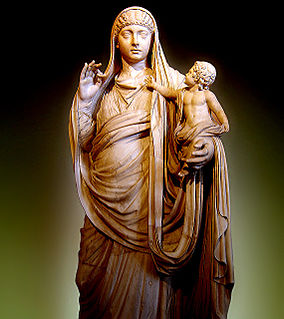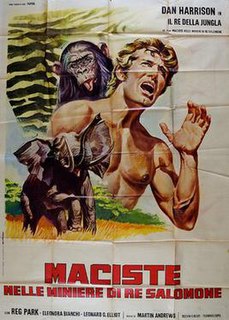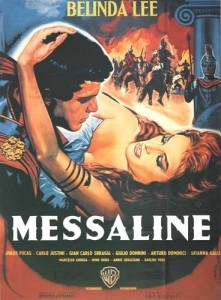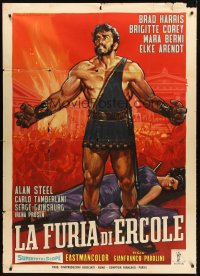
Julia Agrippina, also referred to as Agrippina the Younger, was Roman empress from 49 to 54 AD, the fourth wife and niece of Emperor Claudius.

Valeria Messalina was the third wife of Roman emperor Claudius. She was a paternal cousin of Emperor Nero, a second cousin of Emperor Caligula, and a great-grandniece of Emperor Augustus. A powerful and influential woman with a reputation for promiscuity, she allegedly conspired against her husband and was executed on the discovery of the plot. Her notorious reputation probably resulted from political bias, but works of art and literature have perpetuated it into modern times.

Poppaea Sabina, also known as Ollia, was a Roman Empress as the second wife of the Emperor Nero. She had also been wife to the future emperor Otho. The historians of antiquity describe her as a beautiful woman who used intrigues to become empress.
Claudia Acte was a freedwoman of ancient Rome who became a mistress of the emperor Nero. She came from Asia Minor and might have become a slave of the Emperor Claudius, following his expansion of the Roman Empire into Lycia and Pamphylia; or she might have been purchased later, by Octavia, Claudius' daughter.

Domitia Lepida was a Roman aristocrat, related to the imperial family. She was mother of Valeria Messalina, wife of the Emperor Claudius. Lepida was a beautiful and influential figure. Like her sister, she was also very wealthy. She had holdings in Calabria and owned the praedia Lepidiana.

Tiberius Claudius Narcissus was one of the freedmen who formed the core of the imperial court under the Roman emperor Claudius. He is described as praepositus ab epistulis.

Claudia Octavia was a Roman empress. She was the daughter of the Emperor Claudius and Valeria Messalina. After her mother's death and father's remarriage to her cousin Agrippina the Younger, she became the stepsister of the future Emperor Nero. She also became his wife, as a marriage between the two was arranged by Agrippina.
Nero is an Italian-British-Spanish television film, part of the Imperium series; it was made film available on DVD as of November 2005 in the U.S. and Canada. Produced by EOS Entertainment and Lux Vide for RAI and Telecinco.
A.D. (1985) is an American/Italian miniseries in six parts which adapts the narrative in the Acts of the Apostles. Considered as the third and final installment in a TV miniseries trilogy which began with Moses the Lawgiver (1974) and Franco Zeffirelli's Jesus of Nazareth (1977), it was adapted from Anthony Burgess's 1985 novel The Kingdom of the Wicked, which was itself a sequel to Burgess's book Man of Nazareth, on which was based Zeffirelli's movie. The title is the abbreviation for Anno Domini, as the events occur in the first years of the Christian Era.

Fire Over Rome is a 1965 Italian peplum film directed by Guido Malatesta.

Mio figlio Nerone, released in the US as Nero's Mistress is a 1956 Italian historical comedy film directed by Steno and starring Alberto Sordi, Vittorio De Sica, Gloria Swanson and Brigitte Bardot, with cinematography by Mario Bava. It depicts a visit by the Roman Emperor Nero and his entourage to a coastal villa.

Hercules Against Rome is a 1964 peplum film directed by Piero Pierotti.

Samson in King Solomon's Mines is a 1964 Italian peplum film written and directed by Piero Regnoli.

Messalina is a 1960 Italian peplum film directed by Vittorio Cottafavi.

Satiricosissimo is a 1970 Italian comedy film directed by Mariano Laurenti. It is a parody of the 1969 Federico Fellini film Fellini Satyricon.

The Fury of Hercules is a 1962 peplum film written and directed by Gianfranco Parolini.

The Fall of Rome is a 1963 Italian peplum film written and directed by Anthony Dawson.

The Lion of Thebes is a peplum film written and directed by Giorgio Ferroni.

The Terror of Rome Against the Son of Hercules is a 1964 peplum film directed by Mario Caiano and starring Mark Forest and Marilù Tolo.
















